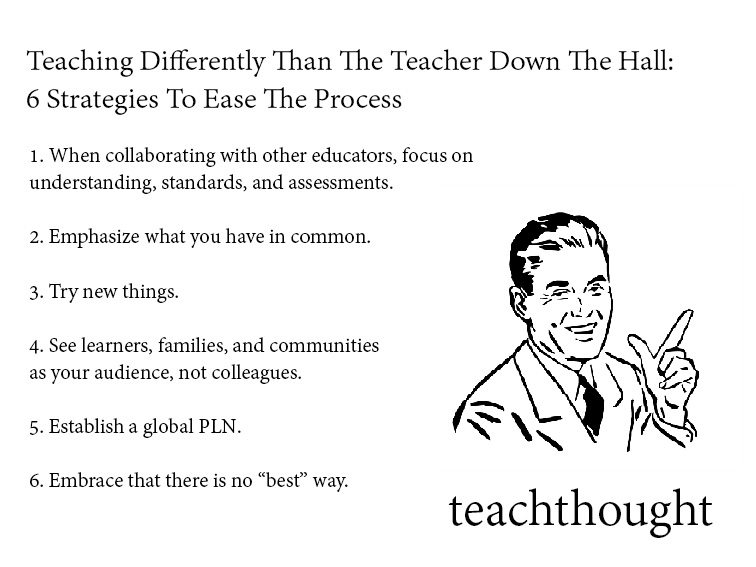
Tips For Getting Along With Teachers That Think Differently Than You
by Terry Heick
While the call to innovate learning is strong, it isn’t an easy process for the classroom teacher even if they have strong understanding, resources, and wherewithal.
With all of the admonishment to drag education (kicking and screaming) into the 21st century, there is precious little support for teachers in understanding the ‘social graces’ in doing so.
You might have students identifying, analyzing, and evaluating through blogs, YouTube, and twitter within project-based learning to find personal, feasible solutions to authentic problems, while the teacher across the hall addresses the same learning standards using similar higher-order thinking, but with a completely different ‘look’: traditional book reports on posterboards, and physical artifacts like milk-jugs dangling on wire-hangers. Same standards, different products. One would think that as long as both teachers teach to those ‘same standards,’ all would be well, but it’s not always that’s simple.
Challenges here surface everywhere, from how to best assess student understanding, to how different units function within increasingly important data-team processes within many public schools. Depending on your local approach, Professional Learning Communities can unwittingly put pressure on teachers to homogenize—not the best route for personalized learning and teaching, much less innovation.
Teaching Differently Than The Teacher Down The Hall
Also, let’s not forget that students talk, parents murmur, and administrators try to reconcile all of your very public work—and thus very public value system and edu-thinking. Unlike many professions, all that you believe as an educator is on display to the world, and open to celebration—and criticism—from every side.
Before all of the quantification of knowledge, conjuring of data, and diagnostic revision of planned instruction, education is first an artistic effort on both the part of the educator and the educated. It is thus very personal, and so adapting your own teaching style to the needs of learners, communities, department members, ‘PLC’ members, various school and district-level administrators is as much an art as the delivery of the content itself.
It can be a tremendous challenge that can be difficult for even the most diplomatic teacher. Here are some tips that can help.
Teaching Differently Than The Teacher Down The Hall: 6 Strategies To Ease The Process
1. When collaborating with other educators, focus on planning, understanding, standards, and assessments. The goal of your teaching is understanding, not to be ‘on the same page’ with everyone else in the department. So start there–understanding of standards as measured by common assessments. Which leads us to…
2. When collaborating with other educators, emphasize what you have in common. It’s easy to focus on differences because differences stand out. Do your best to steer the conversation back to what’s a) important, and b) shared between you.
3. Try new things. Great teachers are always adapting their craft, and willing to try out new ideas. It is amazing the amount of intricacy a great unit or lesson has embedded within it, and many of these ideas are taken piece-meal from others. A great strategy then is to try ‘their way,’ and go all-in when you do so. Maybe they’ll do the same.
4. Embed curriculum within the local community. Do your best to see learners, families, and communities as your primary audience, not colleagues in your department or building. Other teachers and administrators are your friends, colleagues, co-workers, and partners; they’re not your ‘purpose.’
5. Establish a global PLN. If the context for your teaching is small, so will be your resource pool, and your own willingness to adapt to new challenges with new tools and ideas. Push yourself, and connect with a lot of folks that think as you do outside of your school or district–and even more that think differently. This approach can keep you on the leading edge, and hopefully free from peda-dogma.
See also What’s A Professional Learning Network?
6. Embrace that there is no ‘best’ way. While certain hallmarks of teaching and content don’t change, literally every other layer of education does, from the standards themselves, to district “pushes,” available technology, and even what is accepted as a ‘best practices.’ So maybe a better way to put it is, embrace change.